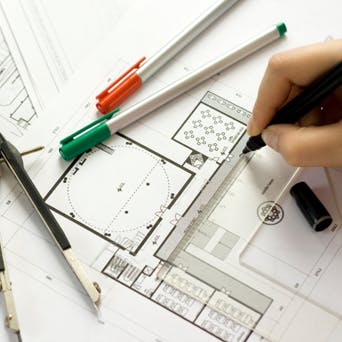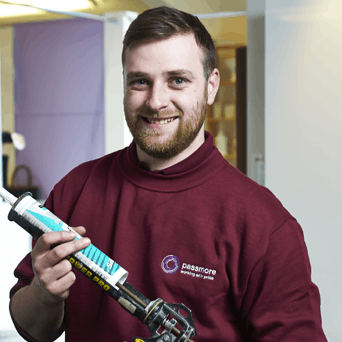Planning a bathroom layout | More Bathrooms
Published: 21 April 2021 · Last Updated: 23 January 2024
In the bathroom industry, we have so many bathroom designs that are available to us, including the popular concepts of modern, traditional, bespoke shower rooms and much more.
The good thing is that whether your bathroom is big, or small you are not limited to a type of design.
That being said the layout of a bathroom is as important as the design itself. To achieve an enjoyable functional bathroom space, the layout and design must be truly thought out. It is the cornerstone of a bathroom’s success.
In this article, we are going to provide in-depth information on how to plan a bathroom layout with all the important elements that should be considered for a bathroom.

Understanding your needs and preferences
To ensure that the bathroom design is both practical and aesthetically pleasing, the first step is to clearly understand the specific requirements and preferences.
You could opt for a designer who'll come to a clear understanding of your needs and preferences by going through a list of elements that need to be considered when you're going down the route of refurbishing your kitchen design. Our designers at More bathrooms would go through this with you and further offer their advice for the bathroom design all as part of our full design and fit service.
The other option you have available is undergoing a self-assessment which individuals can do and it can be considered as a fun activity to do depending on how you do it. Take a conscious look at your usual routine and habits and answer a few questions about functionality, accessibility, and design preferences. Some of those questions might look like:
> How many people will be using the bathroom regularly?
> Are there any specific storage needs for toiletries, towels or other bathroom essentials?
> Preferences regarding natural light, ventilation and privacy?
Other crucial considerations include knowing how often the bathroom is used. If a user has accessible needs then you will have to look at potentially incorporating accessible features to accommodate them.
The last consideration of understanding the needs and preferences of the bathroom layout is the part that most of us enjoy, and that is brainstorming bathroom design ideas. This could include:
> Decide the preference of what you’d like whether it is a walk-in shower, bathtub or maybe a combination of both
> An assessment if you’re able to include storage, a mirror and other features
> The type of lighting you’d like - this would dictate the atmosphere of the space
If you need extra guidance around these points then you can book a free design appointment and one of our experienced designers will be able to take you through a detailed process.
Evaluating your bathroom space
Once you have taken a good look around your existing space and answered the questions about your needs and preferences for a bathroom, then it is time to evaluate the bathroom space you have.
In the UK the average bathroom size is approximately 2m x 2m² and as for an en-suite and shower room average size they don't fall far behind in size.
.jpg?auto=compress%2Cformat&cs=strip&ixlib=php-1.1.0&s=48de9cf2c751f26875490f86c49ea5f4)
The importance of a bathroom evaluation is considered to be the foundational success of a functional and appealing bathroom design.
The first evaluation should be getting the proper measurements of the bathroom.his will enable you to plan a bathroom layout in a maximised space.
Here are a few tips on how to measure your bathroom.
How to measure your bathroom
> Using a measuring tape, choose your first wall and measure from the left to the right corner. Draw a line on a piece of graph paper and note down the measurement.
> Moving clockwise, do the same for the rest of the walls in your bathroom.
> If you have an irregular-shaped bathroom e.g. L shaped, measure these areas as individual rectangles and add the measurements to your sketch.
> Now you have your floor plan measurements, measure the height of your walls from floor to ceiling.
> Finally measure any permanent fixtures including the doorway, windows, and shelves.
Once you have your bathroom dimensions you can play around with fixture locations, using a simple sketch. An example of a small enclosed shower room can be seen below:
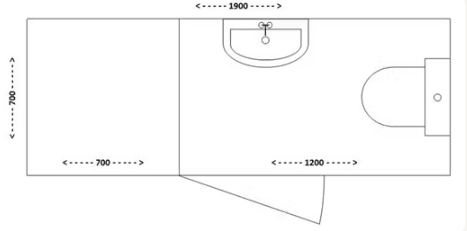
The measurements will be able to provide you with a full floor plan of the bathroom. You also have the option to measure the fixtures to give you a better visual of the layout and how to best reconfigure that bathroom.
On the other hand, you could have a small bathroom layout and the possibilities of reconfiguring your bathroom could well and truly be limited, which could prove to be quite the challenge.
However, there are a few effective strategies to overcome that and it could be to opt for wall-hung bathroom features. The fixtures could include wall-mounted toilets, sinks and cabinets. These floating features create an illusion of extra room with the exposing of the floor and of the features mentioned, there are also compact versions available.
The next possibility for a small bathroom would be going for the vertical storage option which consists of tall narrow cabinets that can be put inside a small bathroom providing the room with effective storage
These are just a few of the many available options that can transform a small bathroom layout into a beautiful space without sacrificing style or comfort.
Exploring common layout options
We are now going to jump into the most common bathroom layouts and this could be a helping hand for you when you’re trying to figure out your bathroom layout.
The most popular layouts are:
> Linear layout
> Alcove layout
> U-shaped layout
> L-shaped layout
> Open concept layout
Understanding your layout and having the measurements in hand can help with decision-making for the available space along with personal and functional preferences.
To give further guidance we are going to go through each layout, help you understand its advantages and disadvantages, and the most suitable bathroom sizes.
> Linear layout
For small bathroom spaces, a narrow linear bathroom option is often the most practical solution.
It offers one of the most simplistic designs as you can put all of the features in one line. The flip side of this is that it is limited in space and most likely will be lacking in storage room.
.jpg?auto=compress%2Cformat&cs=strip&ixlib=php-1.1.0&s=35aec210110e1f4004b5ab73c9d805cd)
> Alcove layout
Is again suited for the smaller bathroom spaces but it does tend to use the scope well. You could even add a mirror to one of the walls to make the space feel more open. The potential issue that people can run into is that the design may lack natural light that comes into the room.
.jpg?auto=compress%2Cformat&cs=strip&ixlib=php-1.1.0&s=ef7eafe5ce73df219d3e6297b1b35783)
> U-shaped layout
Offers plenty of space, storage and counter space, availability. But the most exciting part of the U-shape layout is that it can bring a luxurious atmosphere to the room. What you should watch out for though is not to crowd this bathroom with items that look cluttered. Organisation should be a priority.
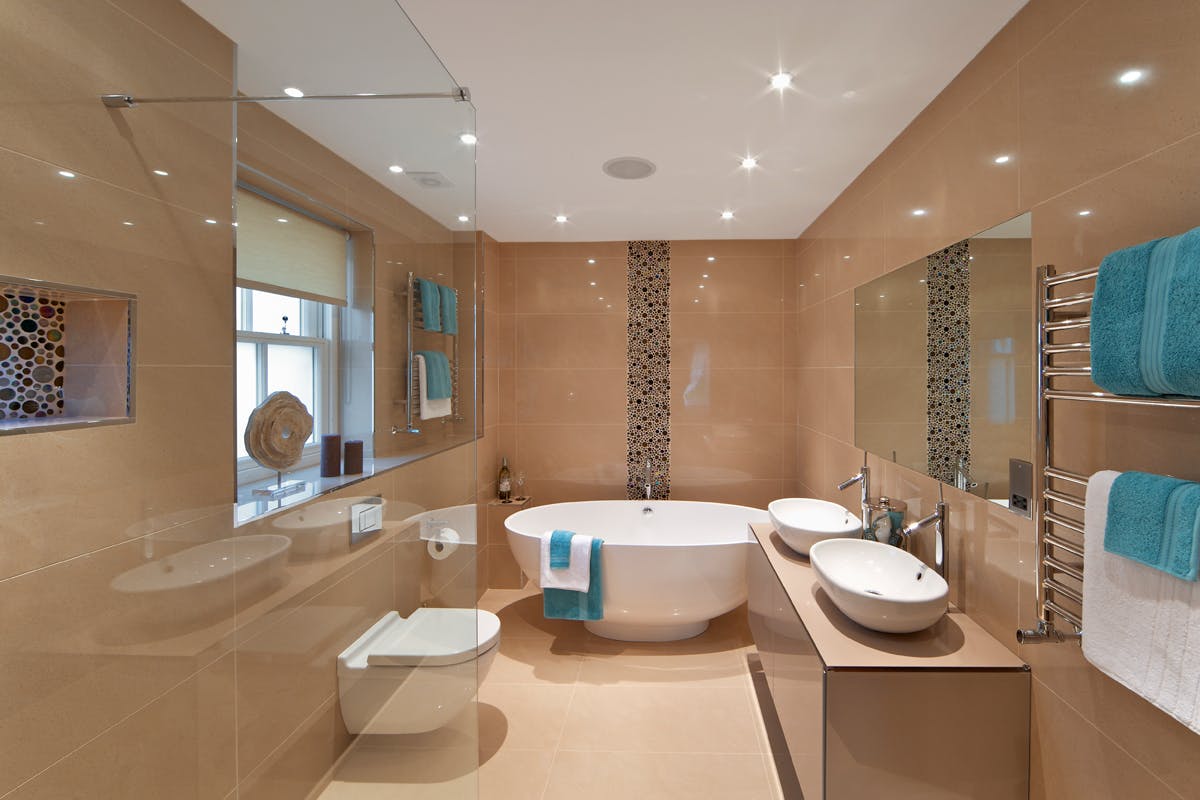
> L-shaped layout
An L-shaped bathroom layout is an efficient bathroom space that uses the available space very well. The layout can also allow the bathroom to be split into sections and for installations of fixtures like the vanity and shower area to go in another section of the room. The only drawback really from an L-shape bathroom layout is that it requires careful design planning to ensure that the concept does not feel cramped.
> Open concept layout
Perfect for the larger bathrooms, with a clear sense of openness. In this layout, you’re given more flexibility with design throughout the layout. Only be mindful of the organisation and keep it clear to not make sure it is chaotic.
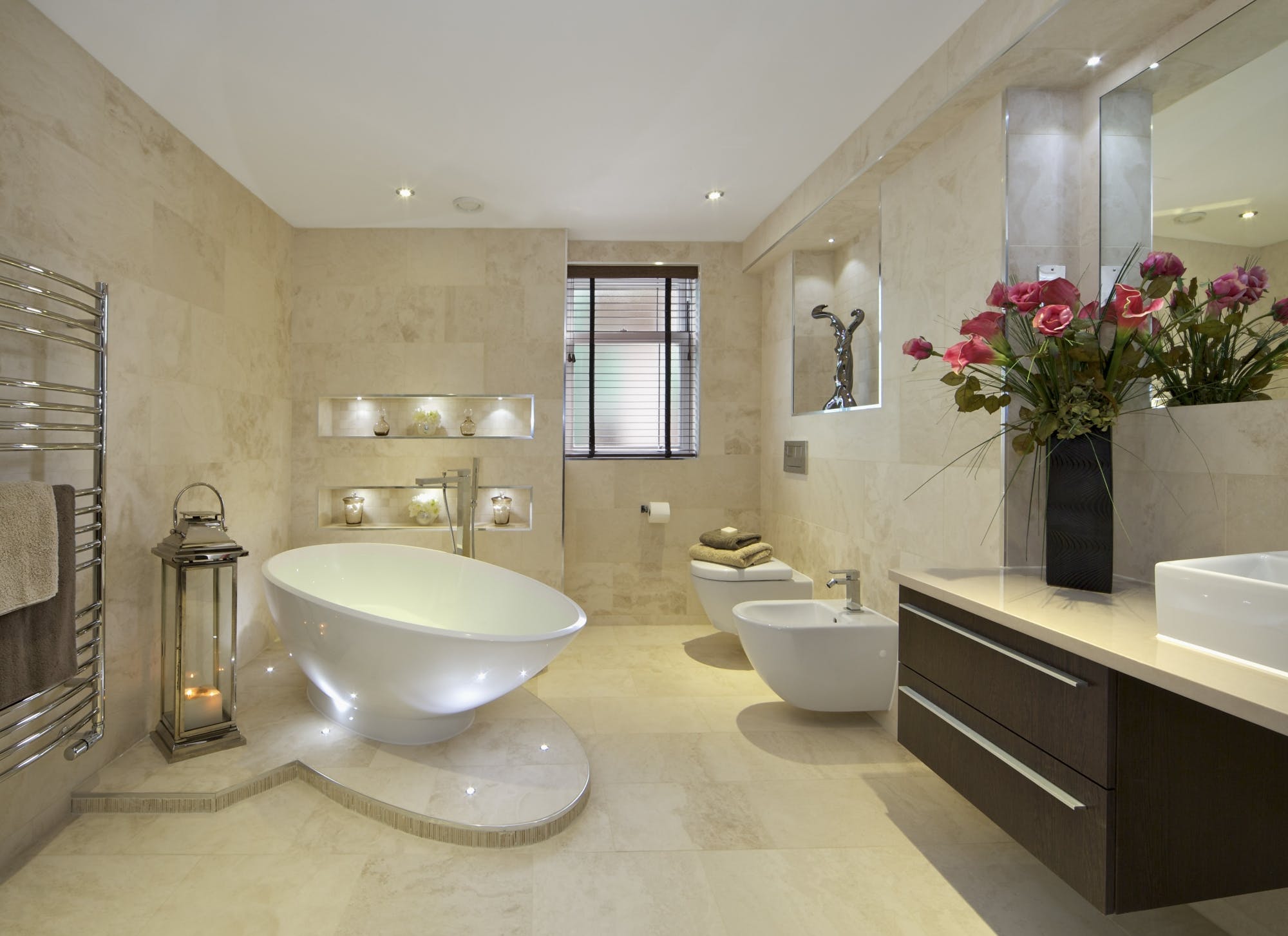
Those are just a few of the popular bathroom layout options. There are more common bathroom layouts with floor plans if you're bathroom doesn't floor plan quite match some of the options we have given.
Selecting the right plumbing fixtures
An integral part of the process is selecting the fixtures of the bathroom and the process of how you go about doing it. There are a few factors to consider which are to ensure functionality, comfort, design appeal, and convenience are met.
To kick off the process would be to consider the functionality features and the unique user needs and preferences. Take for instance, if there are children who will be using the bathroom then it would be beneficial to have child-friendly fixtures installed.
You’d also want to put a budget allocation as the plumbing fixtures costs can vary and prioritise the essential fixtures first.
Design harmony matters and choosing styles and finishes that coordinate well with the overall bathroom theme creates a cohesive complete design.
To not create congestion in a design pick appropriate-sized bathroom features that go with your layout to ensure that the layout remains efficient and comfortable.
Continuing with fixtures and the options we have available to us,
Toilet
> Dual-flush toilet - Offers a two-flush option and has a lower water consumption, a modern design.
> Wall-hung toilet - Typically mounted on the wall and more suited for sleek and modern design.
.PNG?auto=compress%2Cformat&cs=strip&ixlib=php-1.1.0&s=3cbd24c6e047370351f55a8825b49a23)
Sinks
>Wall-hung sink - Sleek design attached to the wall without a pedestal, leaving space underneath.
> Pedestal sink - Supported by a freestanding pedestal and is usually space-saving.
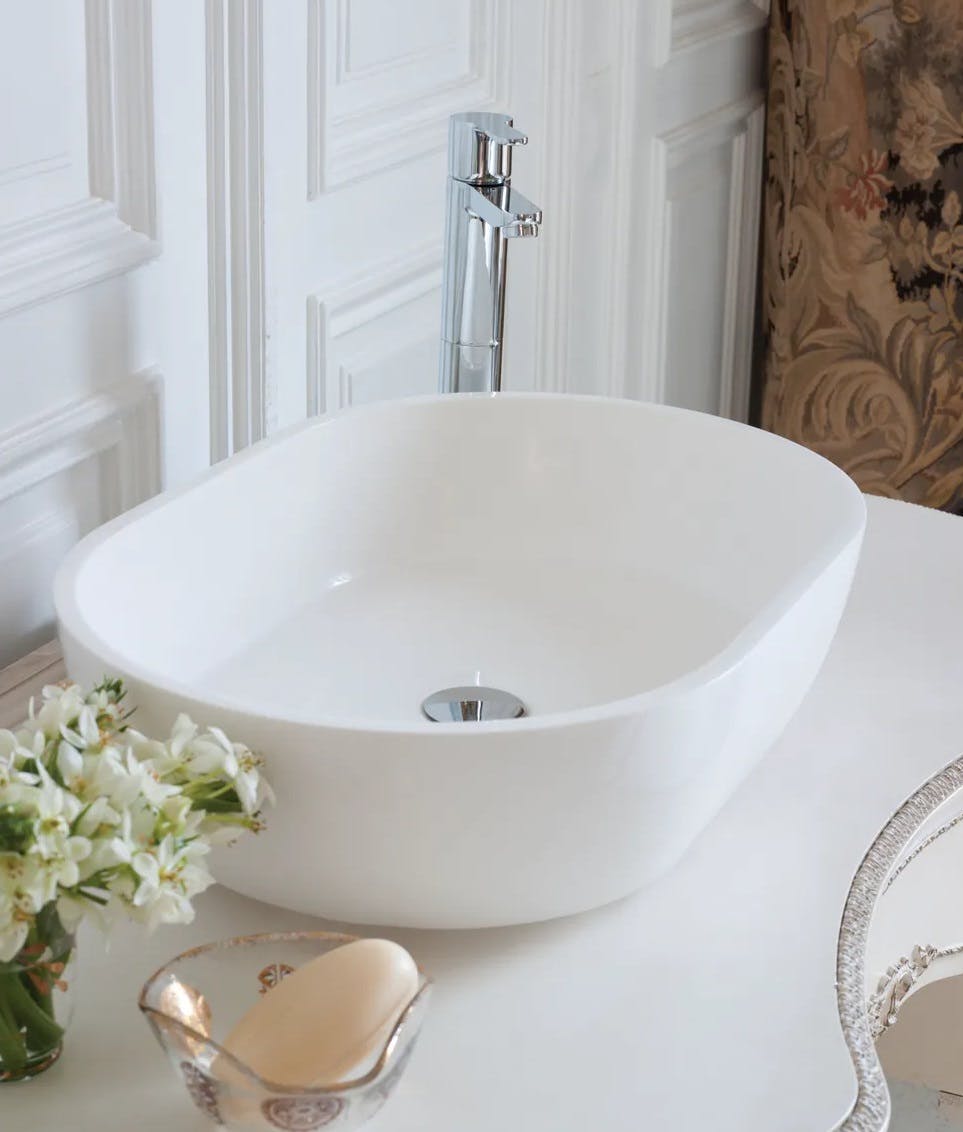
Bathtub
> Alcove bath - Usually installed between three walls and is often combined with the shower.
> Corner Bathtubs - Designed to fit in the corner of a bathroom and maximises space for the efficiency of the bathroom.
.PNG?auto=compress%2Cformat&cs=strip&ixlib=php-1.1.0&s=b073f1aeb533030fa3dfff7e1a913054)
Showers
> Walk-in showers - Open entry into the shower and is easy to enter and exit.
>Shower-tub combos - A combination of both bathtub and shower in one unit and suitable for both showering and bathing.
.jpg?auto=compress%2Cformat&cs=strip&ixlib=php-1.1.0&s=0d8a9c3a30fb0816e82894c053762b24)
That leaves us with the small fixtures like faucets and handles that complete the fixture list when it comes to planning a bathroom layout. Despite them being small they play a crucial role in achieving a complete cohesive design.
We recommend going for matching faucets and handles that match the overall style of your bathroom to blend seamlessly.
Once you’ve chosen your desired tap design then the materials which we advise would be the most suitable would be:
> Brushed nickel
> Oil-rubbed bronze
> Matte black
If you are ever in doubt or need an extra hand when it comes to choosing faucets and their materials then contact a professional for expert advice on coordinating for the overall design.
Choosing materials and finishes
Part of the process of planning a layout is choosing the materials and finishes that will contribute to the overall design of the bathroom. For a long-lasting bathroom, you’d also want to go for materials that can deal with the high-moisture environment and are also eco-friendly.
Popular bathroom features such as tile, wood, stone, metals, and laminate have a range of finishes across different bathroom features that make up a bathroom design. Some of the popular options include:
Tiling
> Ceramic Tiles - A water-resistant and durable option, that is available in many styles. Suitable for both flooring and the wall.
> Porcelain tile - Just like ceramic tiling it is water-resistant, durable, and available in many colours and patterns but is ideal for moist environments.
.jpg?auto=compress%2Cformat&cs=strip&ixlib=php-1.1.0&s=acf2c0af84d450627a629334a2986a9f)
Wood
> Hardwood - Perfect option for bathrooms with low moisture, and creates an inviting atmosphere.
> Engineered wood - Looks like hardwood, and is suitable for bathrooms with moderate levels of moisture.
.jpg?auto=compress%2Cformat&cs=strip&ixlib=php-1.1.0&s=1e52f8ebc959511a13522ae559729f74)
Stone
> Marble - Adds a luxurious look to your bathrooms and has a variety of available colour options. Is a versatile option as it can be used on both the floor and wall.
> Granite - Just like the marble, it has a nice luxury finish, to add it is also quite resistant to scratches.
.jpg?auto=compress%2Cformat&cs=strip&ixlib=php-1.1.0&s=32bfef8d56523b13406fa9d469de1094)
Laminate
One of the most cost-effective options for flooring, and is easy to clean. Resistant to moisture.
Vinyl
A comfortable option that provides insulation. Easy to maintain and is water-resistant and cost-effective.
Quartz
An engineered stone option with high durability. Relatively easy to maintain and has versatile design options available.
Metals
> Stainless steel - A durable option with its rust resistance is quite easy to clean and can come in a variety of finishes including brushed, polished and matte
>Copper - A desirable soft metal, known for its durability.
> Brass - Popular option for vintage or modern designs with its timeless quality. Is an easy material to maintain and is available in a variety of finishes.
When you’re choosing which materials and their finishes then you must consider what you’re attempting to achieve for the overall design. Should you struggle then you should have a designer close by to help guide you.
Creating a functional and stylish space
Designing a bathroom that is both functional and stylish is not an easy feat to overcome, because you have to create a space that accommodates every user of that bathroom.
To create a bathroom that prioritises movement and accessibility there are a few considerations that you have to bear in mind, beginning with the ease of movement and accessibility that might be needed inside of the bathroom.
The bathroom should have a clear zone to allow all the users the ability to manoeuvre around the bathroom more so around the key areas like the toilet, shower, and bathtub.
Another top tip would be to have an adjustable shower head if you have opted to have a shower installed as part of the concept. This will help to accommodate the different heights of the users and make for a more convenient showering experience.
Adding to the functionality of the design, installing storage that is easy to access like pull-out shelves or lower cabinets makes things much easier to reach for all individuals using the bathroom. This also helps to maintain order within the bathroom space.
.jpg?auto=compress%2Cformat&cs=strip&ixlib=php-1.1.0&s=2ec32f325ea3ec227926cb6d22c9bb5a)
Lighting is another factor we have to take into consideration when we’re planning a bathroom layout. It influences the overall design aesthetic and the mood.
If there is a lot of sunlight that generally comes into your bathroom then this can create a fresh sense of openness within the room, as it connects with the outdoors.
There are lighting options available that can be installed in the bathroom including
>Smart Lighting - you to customise the lighting inside the room to suit different moods.
.jpg?auto=compress%2Cformat&cs=strip&ixlib=php-1.1.0&s=daa34e3f8240d189ab7cfc7373f3e295)
>Adjustable spotlights - Offers direct lighting around the bathroom where it is needed enhancing functionality and aesthetics
..jpg?auto=compress%2Cformat&cs=strip&ixlib=php-1.1.0&s=5ecc986e38bc645c8f5f1b25f728bc8e)
>Ambient lighting - This lighting can provide an overall illumination that sets the tone in a bathroom.
Those are just a few of the many lighting possibilities but this is down to the needs and preferences of what kind of atmosphere you want the bathroom to give out.
Do you need assistance in planning your bathroom layout?
That concludes the planning of a bathroom layout, we have provided you with in-depth information and the options that are available when it comes to planning your bathroom.
It boils down to really going through a thoughtful process of knowing your wants and needs for your bathroom design and then going through all of the factors of planning a bathroom.
If you need assistance to help with the planning of your bathroom layout we have a team of experienced designers who can help you through the process. You can book a free design appointment or call us today!
FAQs
What are the most common mistakes people make when planning a bathroom layout?
Common mistakes that people make are that they do not consider the fixtures and some of them can be hard to access or might not fit well with the bathroom.
Another error that people make is that they do not consider the importance of lighting and it is a huge player in the bathroom as the room needs to be bright enough for bathing activities and to relax.
How can I make my bathroom more energy efficient?
There are various ways to make your bathroom energy efficient and that could be to opt for low-flow fixtures. They reduce water usage and can help save money on water bills
Choose LED lighting as it is more energy efficient than traditional incandescent lighting.
How can I create a bathroom that is both functional and stylish?
To ensure that the bathroom is functional then select the materials and finishes that are durable and easy to clean as well as keep in line with the style of the bathroom. In terms of style then you can look to add decorative elements that can add personality to the bathroom and make it more inviting.
Share this Post



.jpg?auto=compress%2Cformat&cs=strip&ixlib=php-1.1.0&s=48de9cf2c751f26875490f86c49ea5f4)
.jpg?auto=compress%2Cformat&cs=strip&ixlib=php-1.1.0&s=35aec210110e1f4004b5ab73c9d805cd)
.jpg?auto=compress%2Cformat&cs=strip&ixlib=php-1.1.0&s=ef7eafe5ce73df219d3e6297b1b35783)


.PNG?auto=compress%2Cformat&cs=strip&ixlib=php-1.1.0&s=3cbd24c6e047370351f55a8825b49a23)

.PNG?auto=compress%2Cformat&cs=strip&ixlib=php-1.1.0&s=b073f1aeb533030fa3dfff7e1a913054)
.jpg?auto=compress%2Cformat&cs=strip&ixlib=php-1.1.0&s=0d8a9c3a30fb0816e82894c053762b24)
.jpg?auto=compress%2Cformat&cs=strip&ixlib=php-1.1.0&s=acf2c0af84d450627a629334a2986a9f)
.jpg?auto=compress%2Cformat&cs=strip&ixlib=php-1.1.0&s=1e52f8ebc959511a13522ae559729f74)
.jpg?auto=compress%2Cformat&cs=strip&ixlib=php-1.1.0&s=32bfef8d56523b13406fa9d469de1094)
.jpg?auto=compress%2Cformat&cs=strip&ixlib=php-1.1.0&s=2ec32f325ea3ec227926cb6d22c9bb5a)
.jpg?auto=compress%2Cformat&cs=strip&ixlib=php-1.1.0&s=daa34e3f8240d189ab7cfc7373f3e295)
.jpg?auto=compress%2Cformat&cs=strip&ixlib=php-1.1.0&s=5ecc986e38bc645c8f5f1b25f728bc8e)

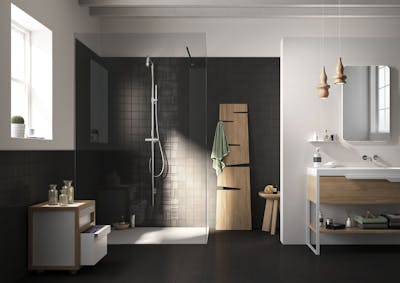
.jpg?auto=compress%2Cformat&cs=strip&fit=clip&h=400&ixlib=php-1.1.0&w=400&s=5eeedabe07060d4a519a0b98e2cb700e)
